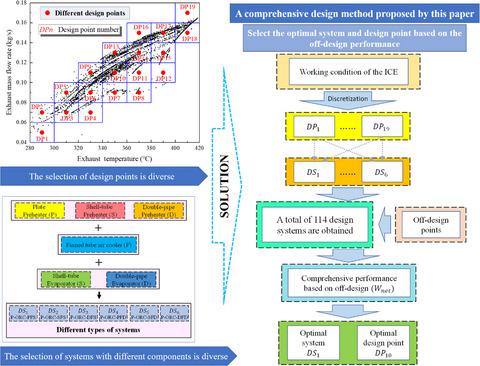当前位置:
X-MOL 学术
›
Energy Sci. Eng.
›
论文详情
Our official English website, www.x-mol.net, welcomes your
feedback! (Note: you will need to create a separate account there.)
A novel design method of organic Rankine cycle system harvesting waste heat of heavy‐duty trucks based on off‐design performance
Energy Science & Engineering ( IF 3.5 ) Pub Date : 2020-11-07 , DOI: 10.1002/ese3.838 Xiaolei Shi 1 , Xuan Wang 1 , Jinwen Cai 1 , Yan Gao 1 , Hua Tian 1 , Gequn Shu 1
Energy Science & Engineering ( IF 3.5 ) Pub Date : 2020-11-07 , DOI: 10.1002/ese3.838 Xiaolei Shi 1 , Xuan Wang 1 , Jinwen Cai 1 , Yan Gao 1 , Hua Tian 1 , Gequn Shu 1
Affiliation

|
The organic Rankine cycle (ORC) system can effectively recover waste heat from engines of heavy‐duty trucks, and is a promising method to improve the efficiency of on‐board engines. However, engine operating conditions fluctuate greatly while driving, the waste heat recovery system must often work under off‐design conditions, which significantly affects system performance. Further, different component structures can also affect the off‐design performance of the system. Thus, a novel design method of preheating organic Rankine cycle (P‐ORC) system harvesting waste heat of heavy‐duty trucks based on off‐design performance is proposed in this study. The design method includes selection of the optimal types of components and design point to optimize the comprehensive performance of the waste heat recovery system in all road conditions. In this study, different heat exchanger combinations are applied to the P‐ORC system to obtain six different design systems. According to the principle of uniform coverage, the scatter diagram of exhaust temperature and mass flow rate of the engine under real road conditions are discretized into 19 alternative design points. Each system is designed with 19 discretized design points, and a total of 114 design systems are obtained. The optimal heat exchanger combination and design point are selected based on the off‐design performance. It is concluded that a P‐ORC system using a combination of plate preheater, finned tube air cooler, and shell‐tube evaporator is the optimal system. The optimal design point number is 10, and the corresponding engine speed at  is 1471 rpm, the engine torque is 474 Nm, the occurrence probability is 14.48%, the exhaust temperature is 350°C, the exhaust mass flow rate is 0.11 kg/s, and the maximum combined net power output is 4.26 kW. The results reveal that the optimal design point of the system can be selected at the design point with medium engine load and high occurrence probability. It guides the system design toward a more practical direction, so as to obtain an optimal system that could operate efficiently and recover more waste heat under the full working conditions of the engines. This novel design method can be extended for other cycle configurations.
is 1471 rpm, the engine torque is 474 Nm, the occurrence probability is 14.48%, the exhaust temperature is 350°C, the exhaust mass flow rate is 0.11 kg/s, and the maximum combined net power output is 4.26 kW. The results reveal that the optimal design point of the system can be selected at the design point with medium engine load and high occurrence probability. It guides the system design toward a more practical direction, so as to obtain an optimal system that could operate efficiently and recover more waste heat under the full working conditions of the engines. This novel design method can be extended for other cycle configurations.
中文翻译:

基于非设计性能的有机朗肯循环系统收集重型卡车余热的新方法
有机朗肯循环(ORC)系统可以有效地回收重型卡车发动机的废热,是提高车载发动机效率的有前途的方法。但是,在行驶过程中,发动机工况波动很大,废热回收系统通常必须在非设计条件下工作,这会严重影响系统性能。此外,不同的组件结构也会影响系统的设计外性能。因此,本研究提出了一种基于非设计性能的预热有机朗肯循环(P-ORC)系统以收集重型卡车废热的新设计方法。设计方法包括选择最佳组件类型和设计要点,以在所有道路条件下优化废热回收系统的综合性能。在这个研究中,将不同的热交换器组合应用于P-ORC系统以获得六个不同的设计系统。根据均匀覆盖原理,将真实道路条件下发动机排气温度和质量流率的散点图离散为19个替代设计点。每个系统设计有19个离散设计点,总共获得114个设计系统。根据非设计性能选择最佳的热交换器组合和设计点。结论是,结合使用板式预热器,翅片管空气冷却器和壳管式蒸发器的P‐ORC系统是最佳系统。最佳设计点数为10,相应的发动机转速为 根据均匀覆盖原理,将真实道路条件下发动机排气温度和质量流率的散点图离散为19个替代设计点。每个系统设计有19个离散设计点,总共获得114个设计系统。根据非设计性能选择最佳的热交换器组合和设计点。结论是,结合使用板式预热器,翅片管空气冷却器和壳管式蒸发器的P‐ORC系统是最佳系统。最佳设计点数为10,相应的发动机转速为 根据均匀覆盖原理,将真实道路条件下发动机排气温度和质量流率的散点图离散为19个替代设计点。每个系统设计有19个离散设计点,总共获得114个设计系统。根据非设计性能选择最佳的热交换器组合和设计点。结论是,结合使用板式预热器,翅片管空气冷却器和壳管式蒸发器的P‐ORC系统是最佳系统。最佳设计点数为10,相应的发动机转速为 每个系统设计有19个离散设计点,总共获得114个设计系统。根据非设计性能选择最佳的热交换器组合和设计点。结论是,结合使用板式预热器,翅片管空气冷却器和壳管式蒸发器的P‐ORC系统是最佳系统。最佳设计点数为10,相应的发动机转速为 每个系统设计有19个离散设计点,总共获得114个设计系统。根据非设计性能选择最佳的热交换器组合和设计点。结论是,结合使用板式预热器,翅片管空气冷却器和壳管式蒸发器的P‐ORC系统是最佳系统。最佳设计点数为10,相应的发动机转速为 转速为1471 rpm,发动机扭矩为474 Nm,发生概率为14.48%,排气温度为350°C,排气质量流量为0.11 kg / s,最大组合净功率输出为4.26 kW。结果表明,该系统的最佳设计点可以在中等发动机负荷和高发生概率的设计点进行选择。它引导系统设计朝着更实际的方向发展,从而获得可以在发动机的全部工作条件下高效运行并回收更多废热的最佳系统。这种新颖的设计方法可以扩展到其他循环配置。
转速为1471 rpm,发动机扭矩为474 Nm,发生概率为14.48%,排气温度为350°C,排气质量流量为0.11 kg / s,最大组合净功率输出为4.26 kW。结果表明,该系统的最佳设计点可以在中等发动机负荷和高发生概率的设计点进行选择。它引导系统设计朝着更实际的方向发展,从而获得可以在发动机的全部工作条件下高效运行并回收更多废热的最佳系统。这种新颖的设计方法可以扩展到其他循环配置。
更新日期:2020-11-07
 is 1471 rpm, the engine torque is 474 Nm, the occurrence probability is 14.48%, the exhaust temperature is 350°C, the exhaust mass flow rate is 0.11 kg/s, and the maximum combined net power output is 4.26 kW. The results reveal that the optimal design point of the system can be selected at the design point with medium engine load and high occurrence probability. It guides the system design toward a more practical direction, so as to obtain an optimal system that could operate efficiently and recover more waste heat under the full working conditions of the engines. This novel design method can be extended for other cycle configurations.
is 1471 rpm, the engine torque is 474 Nm, the occurrence probability is 14.48%, the exhaust temperature is 350°C, the exhaust mass flow rate is 0.11 kg/s, and the maximum combined net power output is 4.26 kW. The results reveal that the optimal design point of the system can be selected at the design point with medium engine load and high occurrence probability. It guides the system design toward a more practical direction, so as to obtain an optimal system that could operate efficiently and recover more waste heat under the full working conditions of the engines. This novel design method can be extended for other cycle configurations.
中文翻译:

基于非设计性能的有机朗肯循环系统收集重型卡车余热的新方法
有机朗肯循环(ORC)系统可以有效地回收重型卡车发动机的废热,是提高车载发动机效率的有前途的方法。但是,在行驶过程中,发动机工况波动很大,废热回收系统通常必须在非设计条件下工作,这会严重影响系统性能。此外,不同的组件结构也会影响系统的设计外性能。因此,本研究提出了一种基于非设计性能的预热有机朗肯循环(P-ORC)系统以收集重型卡车废热的新设计方法。设计方法包括选择最佳组件类型和设计要点,以在所有道路条件下优化废热回收系统的综合性能。在这个研究中,将不同的热交换器组合应用于P-ORC系统以获得六个不同的设计系统。根据均匀覆盖原理,将真实道路条件下发动机排气温度和质量流率的散点图离散为19个替代设计点。每个系统设计有19个离散设计点,总共获得114个设计系统。根据非设计性能选择最佳的热交换器组合和设计点。结论是,结合使用板式预热器,翅片管空气冷却器和壳管式蒸发器的P‐ORC系统是最佳系统。最佳设计点数为10,相应的发动机转速为 根据均匀覆盖原理,将真实道路条件下发动机排气温度和质量流率的散点图离散为19个替代设计点。每个系统设计有19个离散设计点,总共获得114个设计系统。根据非设计性能选择最佳的热交换器组合和设计点。结论是,结合使用板式预热器,翅片管空气冷却器和壳管式蒸发器的P‐ORC系统是最佳系统。最佳设计点数为10,相应的发动机转速为 根据均匀覆盖原理,将真实道路条件下发动机排气温度和质量流率的散点图离散为19个替代设计点。每个系统设计有19个离散设计点,总共获得114个设计系统。根据非设计性能选择最佳的热交换器组合和设计点。结论是,结合使用板式预热器,翅片管空气冷却器和壳管式蒸发器的P‐ORC系统是最佳系统。最佳设计点数为10,相应的发动机转速为 每个系统设计有19个离散设计点,总共获得114个设计系统。根据非设计性能选择最佳的热交换器组合和设计点。结论是,结合使用板式预热器,翅片管空气冷却器和壳管式蒸发器的P‐ORC系统是最佳系统。最佳设计点数为10,相应的发动机转速为 每个系统设计有19个离散设计点,总共获得114个设计系统。根据非设计性能选择最佳的热交换器组合和设计点。结论是,结合使用板式预热器,翅片管空气冷却器和壳管式蒸发器的P‐ORC系统是最佳系统。最佳设计点数为10,相应的发动机转速为
 转速为1471 rpm,发动机扭矩为474 Nm,发生概率为14.48%,排气温度为350°C,排气质量流量为0.11 kg / s,最大组合净功率输出为4.26 kW。结果表明,该系统的最佳设计点可以在中等发动机负荷和高发生概率的设计点进行选择。它引导系统设计朝着更实际的方向发展,从而获得可以在发动机的全部工作条件下高效运行并回收更多废热的最佳系统。这种新颖的设计方法可以扩展到其他循环配置。
转速为1471 rpm,发动机扭矩为474 Nm,发生概率为14.48%,排气温度为350°C,排气质量流量为0.11 kg / s,最大组合净功率输出为4.26 kW。结果表明,该系统的最佳设计点可以在中等发动机负荷和高发生概率的设计点进行选择。它引导系统设计朝着更实际的方向发展,从而获得可以在发动机的全部工作条件下高效运行并回收更多废热的最佳系统。这种新颖的设计方法可以扩展到其他循环配置。











































 京公网安备 11010802027423号
京公网安备 11010802027423号